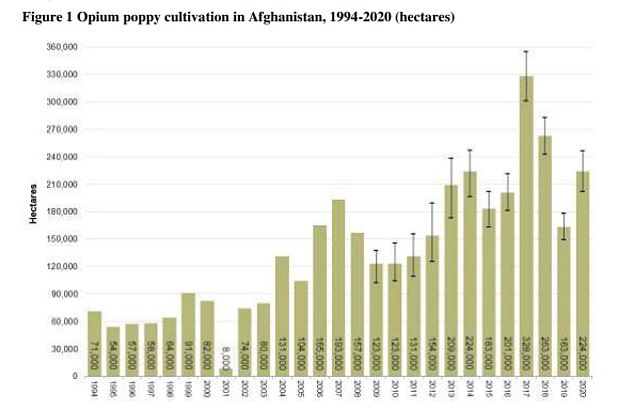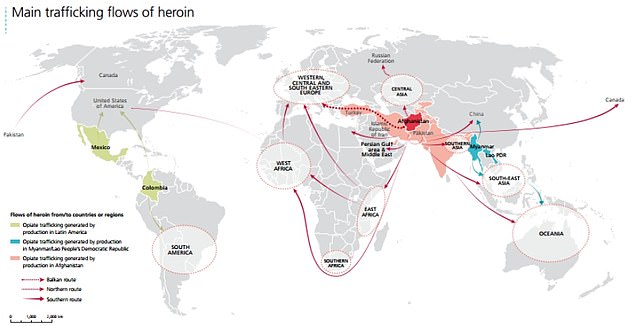The Taliban’s seizing of Afghanistan could flood British and European streets with deadly super-strength heroin, experts fear.
The Islamist terror group relies heavily on the war-torn country’s multi-billion-pound opium trade.
Production increased last year in the country, which already makes up two-thirds of the world’s opium supply.
Ian Hamilton, a drug addiction researcher at the University of York, claimed it was a problem ‘coming down the road’.

Afghanistan produced 37 per cent more opium last year, a report by the United Nations revealed. The country cultivated opium from 224,000 hectares of poppy fields – an area 50 per cent bigger than the entirety of Greater London

Heroin is made from opium that is removed from the pods in certain poppy plants, which is turned into morphine and then heroin. (Pictured: an Afghan man working on a poppy field in Nangarhar, eastern Afghanistan, in April 2016)

The Balkan route (red dotted line) is the main pathway for opiates from Afghanistan to be smuggled into Europe, which is the where the majority of heroin produced in the country ends up. It is usually smuggled through Iran, Turkey and the Balkans. Meanwhile, most of the opiates taken in the US arrived from Mexico and Colombia
Heroin and morphine behind most drug-related deaths in 2020
Opiates heroin and morphine caused nearly 30 per cent of all drugs deaths in England and Wales last year.
Office for National Statistics data showed 4,561 deaths in England and Wales registered last year were related to drug poisoning in 2020, marking the ninth successive year that drug fatalities have risen.
And heroin and morphine sparked 1,337 deaths – more than any other drug. This marks an increase of 69 per cent on 10 years ago.
Heroin caused more deaths than cocaine (777), antidepressants (517) and methadone (516).
Many of those who died from taking illegal drugs were born in the 1970s. The victims include members of the so-called ‘Trainspotting generation’ that live in poorer towns and cities and became addicted to heroin in the 1990s when prices were cheap.
Experts slammed the data as ‘tragic and concerning’, and called on ministers to urgently dish out extra support to fix the ‘public health emergency’.
Health Secretary Sajid Javid said the Government ‘is committed to tackling drug misuse and saving lives’. Ministers are now proposing to make naloxone — a medicine that can reverse the effects of an opioid overdose — more widely available.
Meanwhile, MDMA, also known as ecstasy, was behind ten times more deaths than in 2010, and among men fatalities linked to the drug were thirteen times higher than ten years ago.
Cocaine-related fatalities jumped almost five-fold over the same period to 777, with rates among women soaring from just 19 to almost 160.
And deaths involving benzodiazepine — a class of powerful sleeping pills that include Xanax and Valium — rose by almost 60 per cent in ten years.
Experts said today the figures were sad but not surprising, especially for cocaine ‘given that [the drug] is so readily available and as easy to order as a Deliveroo’.
The ONS figures cover 2020 but because of registration delays most of the fatalities occurred the previous year, meaning they do not show how lockdown may have encouraged the use of illegal drugs. Experts said successive shutdowns were only likely to spark a rise in drug-linked deaths.
It comes after Scotland recorded a record high 1,339 drug-related deaths in 2020, the worst drugs death rate in Europe.
Advertisement
He told MailOnline: ‘Opium production has increased significantly over the past year – and that’s not a coincidence.
‘There’s been less and less official control over production and distribution. That opium yield increase is going to find its way into Western markets.
‘And the worrying thing about that is, if the yield increases, you end up with stronger, more potent heroin because there is less need to dilute it.’
Heroin — usually sold as a brown powder — is produced from morphine, which is extracted from the pods of opium poppy plants.
Super-strength heroin is more likely to cause addicts to overdose, charities say.
New heroin users may think they are taking a safe dose in line with what has been suggested to them, when it is actually much stronger.
And regular users will keep taking the same quantity without knowing its potentially deadly strength.
Mr Hamilton said ‘it’s a bit like regularly drinking pints then all of a sudden switching to spirits’.
Afghanistan accounts for almost two-thirds of all opium produced across the world, according to the United Nations.
A UN report published in May claimed Afghanistan last year saw a 37 per cent increase in the amount of opium produced.
The country cultivated opium from 224,000 hectares of poppy fields – an area 50 per cent bigger than the entirety of Greater London.
Europe is the main destination for heroin produced in Afghanistan. It is usually smuggled through Turkey and the Balkans.
Meanwhile, most of the opiates taken in the US were trafficked from Mexico and Colombia.
Crystal meth is also becoming a problem in the country, with the the European Monitoring Centre for Drugs and Drug Addiction warning it could become as big an industry in the country as heroin.
Experts pinned the growing production and supply of the crystal meth on drug smugglers finding ephedra, the plant used to make ephedrine, which is a key component of the drug, growing wild in the country’s mountains.
It comes after health chiefs yesterday issued a warning about heroin overdoses, following more than a dozen recent deaths.
There have been at least 46 poisonings in South London, the South East, South East and East of England over the past fortnight.
Public Health England said urgent investigations with the police are still ongoing.
And it said there are early signs the overdoses may have been caused by batches of heroin mixed with a potent and dangerous synthetic opioid.
Officials did not say what the mixed drug could be – but experts suggested it could be fentanyl or spice.
Fentanyl, a strong opioid painkiller designed to treat severe pain, is 50 times more potent than heroin and has been linked to thousands of deaths in the US.
It comes as drug deaths in the UK hit 4,561 in England and Wales in 2020, the highest level since 1993.
Source link : https://www.dailymail.co.uk/news/article-9904323/Talibans-seizing-Afghanistan-flood-British-streets-deadly-super-strength-heroin.html











